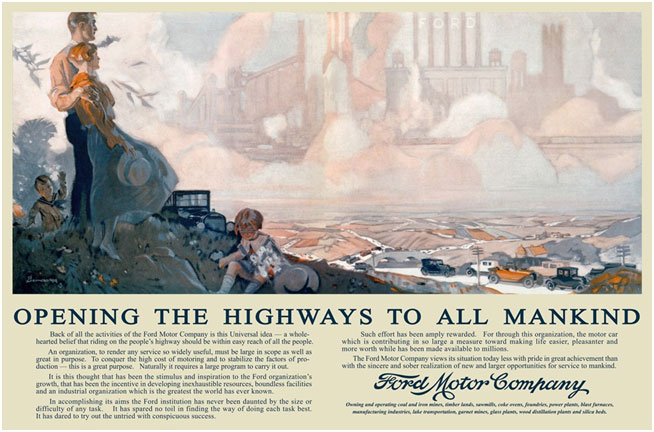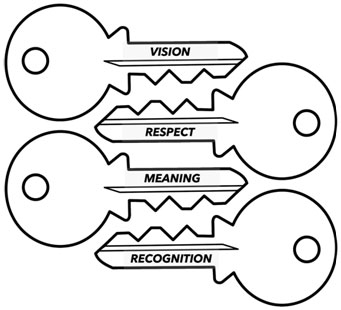It’s often said that “People don’t quit a job, they quit a boss”. However, it’s also true that most bosses and managers really do want to succeed in their jobs, win the admiration of their team and inspire greatness in their staff.
Recent engagement surveys have found that when people left their jobs, more often it was because their strengths were underused, that they weren’t growing in their careers, or that they had become disillusioned with the purpose of the company they worked for.
“People are becoming increasingly intolerant
of companies without a compelling cause
and a collaborative culture.”
~ Roger Fairhead
 Compelling Cause
Compelling Cause
What’s the difference you want to make?
Alan Mulally took over as CEO of Ford Motor Company in Sept 2006 just as the financial crisis of 2008 was about to begin, and he found that the iconic carmaker was well on the road to becoming bankrupt with losses of $17bn forecast for that year. Quite quickly he recognised that the company had lost its purpose and its focus and didn’t know what it stood for. He knew that to succeed in keeping the company in business in the long term he needed a clear, compelling, inspiring vision around which to galvanise the turnaround.
Mulally took Ford back to its roots by reusing an advert that the company’s founder had taken out in 1925. Henry Ford’s original inspiring vision was, “Opening the highways to all mankind”. Inspired by that vision Ford had taken the motor car from being a rich man’s toy to becoming a practical means of transport for everyone. Bryce Hoffman wrote about the turnaround in his book “American Icon”, where he explained that “Mulally wanted to get back to Fords’ heritage which was to build a product that made people’s lives better.”
“Opening the highways to all mankind”
~ Ford Motor Company
Alan Mulally had found the Compelling Cause necessary to galvanise the staff into turning that enormous loss into a profit in just a few short years, and through one of the most difficult trading periods in recent history.
 Collaborative Culture
Collaborative Culture
What makes you different?
In 1987, during another particularly difficult trading period associated with what became known as Black Monday, and amid stiff competition and oversupply in the marketplace, a large international aluminium-producing company was in a serious state of decline. It was performing poorly, and investors were expecting a new strategic mission from their newly appointed leader on how he was going to reduce overheads and improve profits so that the company could survive.
Paul O’Neill had just been appointed as the new CEO of Alcoa, one of the largest aluminium-producing organisations in the world, and he was expected to deliver an inspiring talk. He chose to talk about company culture, rather than corporate strategy.
“If you want to understand how Alcoa is doing,
you need to look at our workplace safety figures.”
~ Paul O’Neill
Although Alcoa already had the best safety record in the US aluminium industry, he knew that to retain staff and workers’ loyalty they had a duty of care that they could, and indeed they should, do better. Notably, he said, “If you want to understand how Alcoa is doing, you need to look at our workplace safety figures.”
O’Neill was not content to accept the idea that something inside the company was injuring, and all too often killing, their employees. He saw that he needed to pick a fight with the notion that any organisation could justify an “acceptable” risk of death. O’Neill wanted to fight the idea that any risk –any injury– was acceptable. He instinctively knew that fight wasn’t going to be won by addressing corporate strategy. His fight took him to a head-on collision course with key aspects of the prevailing company culture.
“Culture eats strategy for breakfast”
~ attributed to Peter Drucker
Was Peter Drucker right when he said, “Culture eats strategy for breakfast”?
Bill Ford (grandson of Henry Ford) certainly thought so, and so he put that statement prominently on the wall in the boardroom of Ford headquarters.
O’Neill said, “Focusing on worker safety can transform an entire organisation and dramatically improve culture, quality, productivity, communication, and ultimately profits.” What’s more, he staked his job and his career on that idea, and during that difficult trading period he managed to increase the Alcoa stock price by 9x and increase Alcoa income by 7x during his 12-year tenure as CEO.
So, what did he do to make this happen? Well, O’Neill knew that finances were not the objective, rather finances are a consequence of excellence. So how can we focus on excellence at work?
“Finances are not the objective,
they’re a consequence of excellence.”
~ Paul O’Neill
O’Neill’s approach was one we would do well to learn in this post-pandemic season if we want to attract and retain good people into our organisations as we navigate our way into this new post-pandemic era.
Four keys to attracting and retaining good staff
First, identify the Compelling Cause for your company, a purpose to pursue in your work that is bigger than just making a profit. Next, craft roles that they’ll enjoy. This can involve hiring impressive candidates and only then writing their job descriptions, for instance, or rotating current employees out of roles where they’re excelling but not feeling motivated. Then allow them to draw on a wider range of their skills and passions. And finally, minimize work-life trade-offs by carving a path for career development that accommodates their personal priorities.
In an organisation with the potential for truly sustainable greatness you need to treat your employees well by embedding these four keys to attracting and retaining good staff into your organisation.
- CLEAR VISION Identify the Compelling Cause that underpins the purpose of your organisation, and ensure it is clearly understood by all stakeholders.
- SHOW RESPECT Ensure that everyone is treated with dignity and respect without discrimination by everyone they encounter, no matter their ranking, ethnicity, faith, age, disability, orientation, or any other form of discrimination.
- FIND MEANING Give everyone the right tools, training, education, and encouragement so they are enabled to make a contribution that helps them find personal meaning and value in their lives through their activities at work.
- GIVE RECOGNITION Make sure that everyone is recognised regularly for what they do!
 So What!
So What!
When you can attract and retain good people to your organisation, you’ll be able to increase staff retention, reduce staffing costs, and improve overall productivity and profitability. Use these four keys to create a compelling cause and build a collaborative culture in your organisation and you will be able to attract and to retain good staff to take your organisation forward, and then you’ll be able to lead your organisation sustainably into the new era that’s emerging post-COVID.













